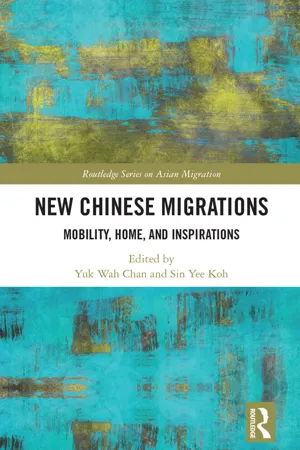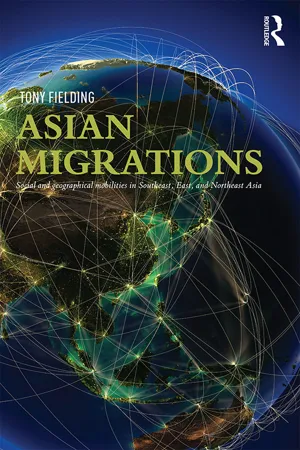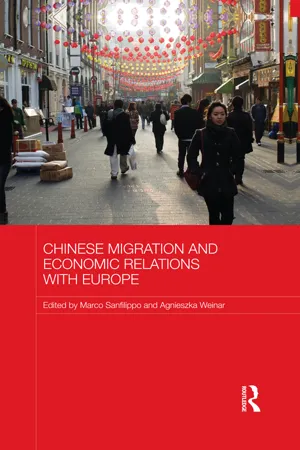History
Chinese Immigration
Chinese immigration refers to the movement of Chinese people to other countries, particularly during the 19th and 20th centuries. This migration was driven by factors such as economic opportunities, political instability, and the search for a better life. Chinese immigrants faced significant challenges, including discrimination and restrictive immigration policies, but they also made valuable contributions to the societies where they settled.
Written by Perlego with AI-assistance
Related key terms
4 Key excerpts on "Chinese Immigration"
- eBook - ePub
The Making of Asian America
A History
- Erika Lee(Author)
- 2015(Publication Date)
- Simon & Schuster(Publisher)
The Chinese who came to the United States paralleled the movement of those who went to Southeast Asia, Australia, New Zealand, and other parts of North and South America. An estimated 550,000 Chinese immigrated to Southeast Asia from 1801 to 1875, while 65,000 went to Australia, 178,000 to the United States, and 30,000 to Canada. 8 The immigration of men like my Moy ancestors especially overlapped with the immigration of other Chinese immigrant men to Canada, Mexico, and Latin America in the late nineteenth and early twentieth centuries. Together, all of these migrations helped to form the modern Chinese diaspora that has lasted for generations. • • • Dreams of gold first propelled Chinese, most from just eight districts in the Pearl River Delta in Guangdong province, to the United States. But it was a mixture of domestic crises and foreign intervention in China that sustained and expanded the immigration of Chinese from this region to the United States over the next several decades. As the center for American and European trade in China, the Pearl River Delta was home to American labor recruiters, businessmen, and missionaries, and the growing American presence in the region helped to establish a lucrative transpacific business in Chinese Immigration. By the 1860s, Hong Kong had become a “city built on migration.” 9 While public opinion often mischaracterized Chinese laborers in the United States as unfree coolies, the system that brought Chinese to the United States was different from the one sending migrants to Latin America. Those heading to the United States did not come under contract and either paid for their own passage or borrowed money for the steamship ticket. The most common way to do this was through the credit-ticket system. Family or district associations lent money for the ticket and borrowers promised to pay it back with interest - eBook - ePub
New Chinese Migrations
Mobility, Home, and Inspirations
- Yuk Wah Chan, Sin Yee Koh(Authors)
- 2017(Publication Date)
- Routledge(Publisher)
5 These movements have also been encouraged by immigration-friendly policies in destination countries that facilitate elite migration. In light of these changes, how can we understand the motivations, processes, and consequences of this new Chinese migration?Secondly, we want to capture the dynamics of Chinese migrations within Asia and the Pacific. As mentioned, we do not just focus on cases of outmigration from mainland China; we also examine the increasingly common trend of intraregional and intrasubregional migration by Chinese migrants from HK, Taiwan and Southeast Asian countries with established Chinese communities. There are reasons for such a rising trend. Expanding economies in Asia have provided much of the economic aspiration for Chinese, as well as other Asians, to move within the region to attain economic benefits (e.g., exploiting cheap resources and pursuing job and investment opportunities) as well as to accumulate social and cultural capitals (e.g., education and social relations) for subsequent economic gains. At the same time, increasingly integrated economies in Asia, receding political antagonism (such as that between China and Vietnam and between China and Taiwan), and cross-border capital and information flows between countries of origin and destination mean that more Chinese (as well as other Asians) can take part in transnational and/or cross-border migration more easily than before. Preferential migration policies targeting Chinese migrants also contribute to these emergent migration flows (e.g., HK’s preferential policies towards mainland Chinese students and China’s polices catering to incoming Taiwanese students and entrepreneurs). Shifting politics in the region and corresponding policy changes thus contribute towards the increasingly intertwined migration relations between subregions, subsequently leading to the formation of specific migration corridors (e.g., China–HK–Taiwan, Malaysia–Singapore, Malaysia–China–HK–Taiwan) and the diversified forms of migration (such as education, business, marriage, birth tourism-led migration and lifestyle migration). These new Chinese migrations highlight the complexities of being ‘Chinese’ in different origin and host contexts. - eBook - ePub
Asian Migrations
Social and Geographical Mobilities in Southeast, East, and Northeast Asia
- Tony Fielding(Author)
- 2015(Publication Date)
- Routledge(Publisher)
The second distinctive feature of recent emigration from the PRC is the sudden appearance of many Chinese (maybe as many as 1 million ‘Chinese’) in sub-Saharan Africa. Journalistic misrepresentations of this process emphasize the ‘land-grab’ aspect of this new presence, the idea being that the rapid growth in the need for food in China, and the lack of confidence in global food markets, is encouraging the Chinese government and business interests to invest in land in countries like Tanzania and Mozambique to secure future food supplies. However, the arrival of the Chinese in Africa is both more complex and more interesting than this. Most of the Chinese are there for purposes of trade and investment. Africa supplies all sorts of products for the Chinese market, but the key ones are oil and gas, the many minerals such as copper and rare earths needed for Chinese manufacturing industry, and certain food and other products not available in China. Other Chinese are the temporary migrant employees (both professional-technical and manual) of major companies engaged in infrastructure projects in Africa, while yet others, though still very small in number, are trying to make a living as farmers. Most, though, are there as the proprietors of small family businesses (as has so often been the case in earlier Chinese migrations). They own shops, run bars and brothels, provide personal services (as barbers, etc.), and generally insert themselves into that part of the local economy which involves exchange and distribution.5.5 Illegal migration from China: traffickingIn the 1980s and 1990s China became a major source country for illegal migration. While some of this was sex trafficking, most was for labour exploitation. Organized crime syndicates were involved in the process. It was said that the ‘Snakehead’ gangs were in charge, and that they linked up with criminal organizations in the destination countries, notably the Yakuza in Japan and Mafia in the USA. Closer inspection of the trafficking process, however, showed that it was more typically the case that migrants were being channelled by small-scale loosely connected networks of agents, many of them linked to one another by family and/or hometown origin. The ‘granny’ human-smuggling entrepreneur of a small town in Fujian Province seemed to be the norm rather than the exception.5.6 Chinese Immigration: return migrationThere are six main types of post-1950 immigration to the PRC. The first to appear was the migration of business people (almost entirely ethnic Chinese men) in the early years following the opening up of China after 1978. One of the largest groups of such migrants was those from Taiwan (the taishang). They were particularly involved in the investments made by Taiwanese companies in the Pearl River Delta region, for example in Shenzen and Dongguan, using low-cost, locally recruited labour (much of it female) to produce cheap consumer goods such as toys, clothing and footwear, electrical goods, etc. Hong Kong-based companies also figured prominently in these early ventures. Over time the business immigrants came to form close-knit communities, often relating strongly with their origin countries but rather little, despite their guanxi - Marco Sanfilippo, Agnieszka Weinar(Authors)
- 2017(Publication Date)
- Routledge(Publisher)
2The role of migration in shaping China’s economic relations with its main partners Haiyan ZhangAbstract
This chapter studies the key features and trends of China’s international immigration and analyses its impact on the trade and foreign direct investment (FDI) flows between China and its major European partner countries. The main focus is to examine possible interaction among trade, FDI and migration flows and to assess the role of Chinese ethnic communities and migration in facilitating these economic exchanges. The impact of Chinese migration/ethnic communities on host economies, especially with regard to entrepreneurial activities, has been also briefly examined. It is concluded that within the ongoing globalization process, Chinese migrant entrepreneurs emerged as an important source of capital, knowledge, market information and business opportunities and contributed to job creation, innovation and economic growth of host countries.Introduction
It is well known that overseas Chinese1 have significantly contributed to the success of China’s economic development during the past 30 years, especially during the first stage of the economic liberalization process.2 They have been the major source of China’s inward foreign direct investment, technology, management know-how and expertise about the international markets (Gao 2003; Huang et al. 2008; Smart & Hsu 2004). The contribution of ethnic Chinese communities to the national economic development in Southeast Asian countries has also been very well documented, and their cross-board business and entrepreneurial networks are considered one of the most important factors for regional economic integration in Southeast Asia (Yeung 1999; Yeung & Olds 2000; Zhang & Van Den Bulcke 2000; Zhuang & Wang 2010). Have the ethnic communities and migration flows from China contributed to the international trade and foreign direct investment between China and their recipient countries?3
Learn about this page
Index pages curate the most relevant extracts from our library of academic textbooks. They’ve been created using an in-house natural language model (NLM), each adding context and meaning to key research topics.



